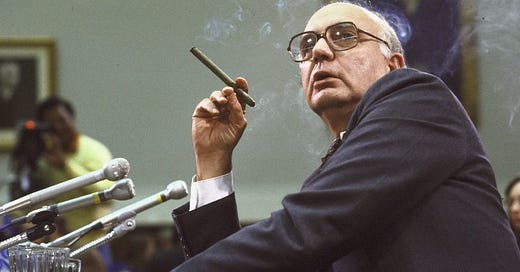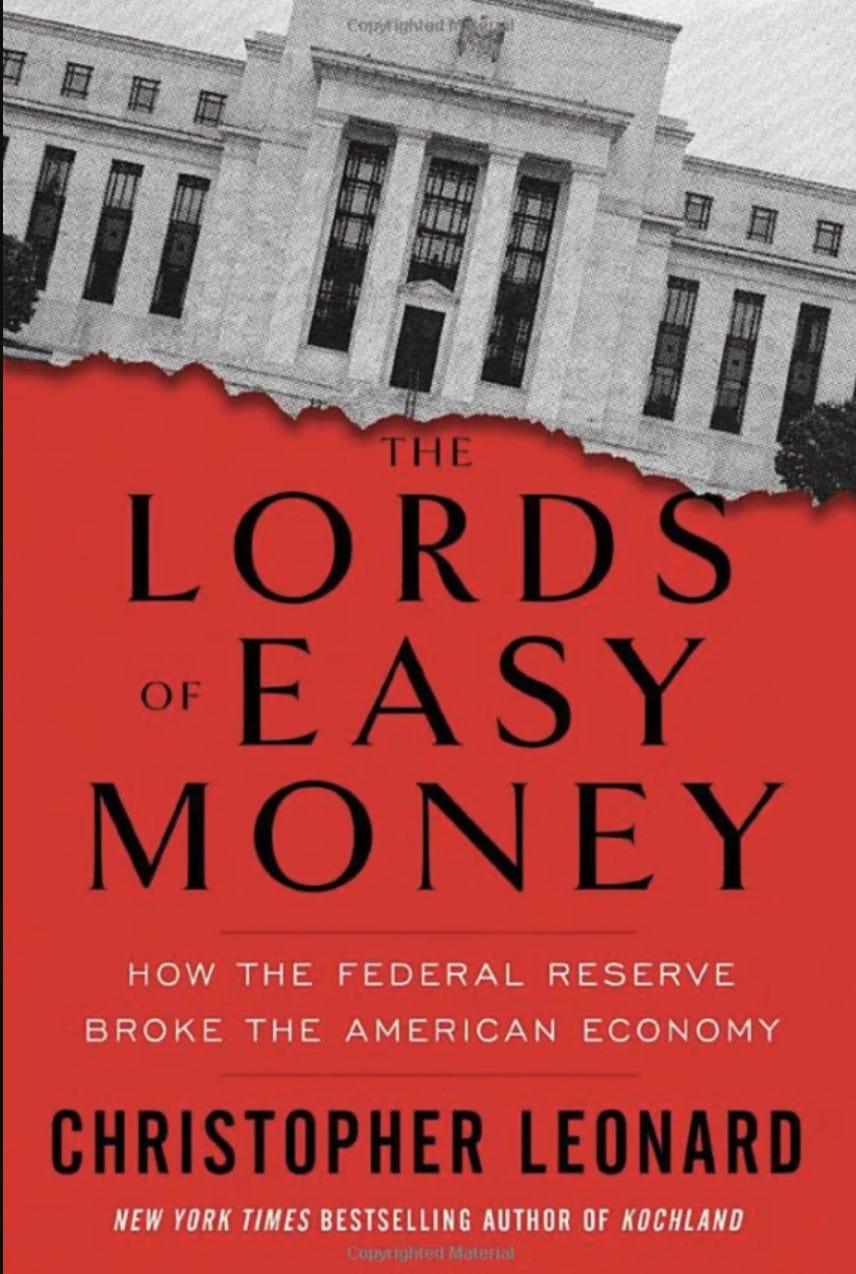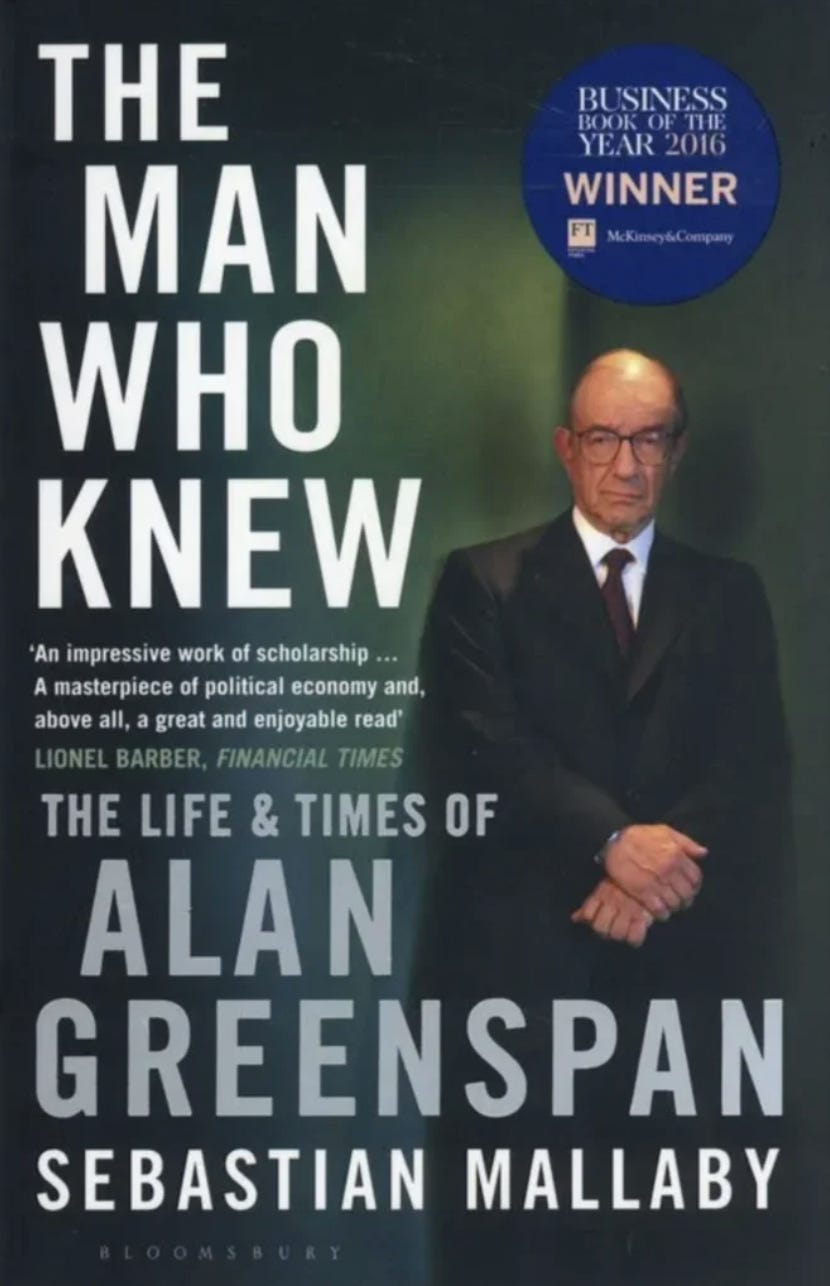Paul Volcker didn't save the economy. He trashed it.
When people look back at 1970s inflation, they miss the real story.
I have long observed that asset price inflation, which benefits the owners of assets, the rich, does not excite the same level of public debate and anxiety as consumer price inflation (CPI). And that is why I find myself engrossed in Christopher Leonard’s new book, brutally sub-titled - How the Federal Reserve Broke the American Economy. It is a harsh, and not always fair critique of the economy’s excessive dependence on Fed governors and their immense power over both the global and the US economy. While there is much with which I disagree in Leonard’s analysis, his review of the Fed’s recent history offers insights strikingly relevant to today’s debates.
Part 1 of the book is written from the perspective of Thomas Hoenig, a long serving but now retired President of the Federal Reserve Bank of Kansas City. Hoenig is well known as the only, and lonely Quantitative Easing (QE) dissenter during Ben Bernanke’s term as governor, but his antipathy towards the policies of the Fed’s Open Market Committee (FOMC) dates from the 1970s.
He and his Kansas City team at the Federal Reserve supervised local banks, and that invariably led to arguments with bankers. The substance of disputes centred on a topic of paramount importance: the value of assets. Bankers or creditors often valued their assets higher than supervisors thought they were worth. Those high, and sometimes delusional valuations had consequences; not just for over-extended banks but also for consumer loans at risk of defaulting if the assets, against which loans were guaranteed, fell in value.
While Hoenig’s team of examiners were trying to keep the local banking system safe, they were being undermined, argues Leonard, by the far more powerful arm of the Federal Reserve: FOMC.
(In the late 1970s) the Fed was keeping interest rates extraordinarily low, in part because there had been two recessions between 1970 and 1975…The most obvious effects of this policy showed up in rising prices for consumer goods like food, fuel and electronics…By 1979 inflation had surged to 10.7 percent per year..…
But the Fed wasn’t just inflating consumer prices. It was inflating asset prices as well. This was the form of inflation that alarmed bank examiners like Hoenig…
Hoenig heard about short-term construction loans extended on the theory that property values would rise so quickly that the loan could be refinanced as soon as the building was finished….pushing banks to make riskier loans. (pp 50-51)
Leonard’s perspective on this period is, in my view, too narrowly focussed, but also downright wrong. He (and Hoenig) adopt the monetarist approach, and wrongly believe inflation is a result of the central bankers increasing the supply of money. They both appear to ignore the role the financial deregulation of the 1960s’ played in pushing banks to make riskier loans. And while Leonard mentions the increasing dominance of monetary policy and the ideological neglect of fiscal policy, he takes the point no further.
Even so, what is refreshing about this account is Leonard’s – and Hoenig’s - determination to place equal emphasis on both the asset and consumer price inflation of the 1970s and the decades after. Leonard, in his discussion of Alan Greenspan’s role as governor explains why:
Greenspan had a solid rationale for focusing only on consumer price inflation. For one thing, it was easier to track: The price of gasoline, bread and television sets is easy to collect. It was also more politically popular to fight price inflation than asset inflation. Very few people complained if the Fed took action to bring down the price of consumer goods. But bursting an asset bubble caused immediate pain, and it caused pain especially in the households of the very rich, writes Leonard.
Sebastian Mallaby’s biography of Greenspan, The Man Who Knew….
showed that the decision to fight price inflation rather than asset inflation happened gradually but was unmistakable by the 1990s. This wasn’t just a quirk of the Greenspan era, writes Leonard. It set a permanent pattern. (Emphasis added)
Why does this matter? Because as Leonard writes, asset price inflation was more destructive than consumer price inflation:
..the Great Inflation (of the 1970s) was not usually described in terms of asset bubbles. When people look back on the 1970s, they tend to talk about only one half of the disaster: the shocking inflation of consumer prices, for things like meat and gasoline. But the Great Inflation was so destructive because it was actually two kinds of inflation that were intertwined, and which fed off each other. The other one was the inflation of asset prices, a phenomenon that later became the most important feature of American economic life. Asset inflation was the force behind the dot-com crash of 2000, the housing market crash of 2008, and the unprecedented market crash of 2020, which was precipitated by the coronavirus outbreak.
To be fair, Paul Volcker in 1979 recognised that he was fighting two inflations: both asset and price inflation. He called them “cousins” and acknowledged, writes Leonard, that they had been created by the Fed. In his memoir, Volcker wrote that
“The real danger comes from [the Fed] encouraging or inadvertently tolerating rising inflation and its close cousin of extreme speculation and risk taking, in effect standing by while bubbles and excesses threaten financial markets”
In October 1979 the Fed under Volcker had fixed short-term rates at 11.6 percent. By the end of the month, they would be 16 percent. In less than a year, they reached the high of 20 percent. Volcker was asked if the rate hikes would damage the economy. In remarks that remind one of current central bank complacency, Volcker was largely dismissive of the question, writes Leonard.
“I would be optimistic in the results of these actions,” Volcker said. “I think the best indications that I have now in an uncertain world that it can be accomplished reasonably smoothly.”
Volcker was wrong. The collapse of asset prices created a cascading effect within the banking system. When land and oil prices fell, the entire system fell apart. The financial health of banks collapsed along with asset prices. Panic broke out in 1982. More than a hundred banks failed that year, far more than in any single year since the 1930s. Overall, more than sixteen hundred banks failed between 1980 and 1994. Leonard bemoans
…. the dynamic that so often gets lost in the discussion about the inflation of the 1970s and the collapse and recession of the 1980s. The Fed got credit for ending inflation, and for bailing out the solvent banks that survived it. But new research published many decades later showed that the Fed was also responsible for the whole disaster.
Since 2007 and the Fed’s First Term Auction Facility to ease a liquidity shortage among commercial banks, central bankers have once again, as in the 1970s, significantly eased monetary policy. That is, they have lowered rates and pumped trillions of dollars into the global economy. According to Michael J. Howell of CrossBorder Capital, the stock of global liquidity was fixed to rise to $175 trillion by the end of 2021, twice global GDP (income).
Those trillions of dollars inflated asset prices – and generated booms and bubbles – as the Lords of Easy Money knew they would.
Asset price inflation and the consequent rise in the wealth of the 1% is so normalised, it is scarcely discussed – even by the 99%. But we have lived through forty years of what Whitney Baker rightly calls “hyperfinancialisation” and an orgy of money-funded speculation. “We know nothing but relentless asset appreciation.”
The rich cannot believe their forty years of ‘easy money’ luck.
Watch out now as asset bubbles burst and destructive forces take hold. The first asset class to implode is crypto. If Thomas Hoenig were given a platform he would surely blame the global economy’s excessive dependence on monetary policy, for the coming, and likely violent deflation of asset bubbles.
For an example of deliberate asset price inflation, see Kaye Wiggins in the Financial Times. She explains that private equity groups, including Blackrock, deliberately inflate the value of their own assets – by buying and then selling said assets to themselves. She shows that the buyout business resembles a pyramid scheme with “circular” deals sold between and within private ownership at high valuations – fuelling asset price inflation.
Windscreen repair and replacement company Belron, which operates internationally under brands including Autoglass and Safelite, was valued at €3bn in 2017, when US buyouts group Clayton, Dubilier & Rice agreed to buy a 40 per cent stake.
…In December last year, CD&R sold a minority of its holding to a trio of new investors: Hellman & Friedman, BlackRock’s private equity business and the Singaporean sovereign wealth fund GIC. The deal valued Belron at €21bn, almost 20 times its earnings, roughly twice the multiple that CD&R had originally paid, the person said. CD&R then sold the rest of its stake to its own special purpose vehicle, which it set up especially to own the Belron stake, at the same valuation.






Land value tax would fix this.